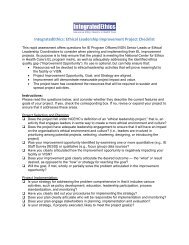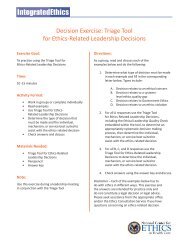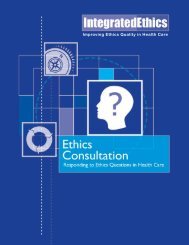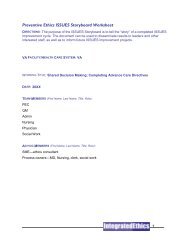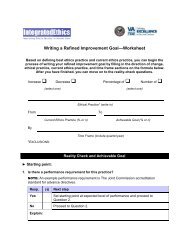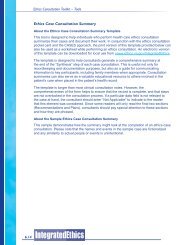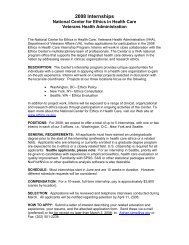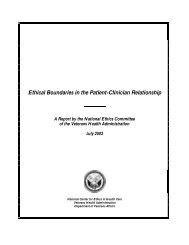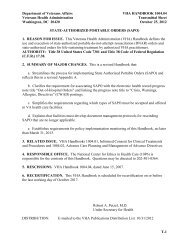Preventive Ethics - National Center for Ethics in Health Care - US ...
Preventive Ethics - National Center for Ethics in Health Care - US ...
Preventive Ethics - National Center for Ethics in Health Care - US ...
Create successful ePaper yourself
Turn your PDF publications into a flip-book with our unique Google optimized e-Paper software.
Part III: ISSUES—A Step-by-Step Approach to <strong>Preventive</strong> <strong>Ethics</strong><br />
Prioritize the issues and select one<br />
With a list of ethics issues categorized by doma<strong>in</strong> and type of quality gap, descriptions of<br />
improvement goals, and work<strong>in</strong>g titles <strong>in</strong> hand, the team should prioritize them and decide<br />
which issue to address first. Because time and resources are f<strong>in</strong>ite, the team should select<br />
an issue <strong>for</strong> which the improvement ef<strong>for</strong>t is likely to have a real impact on the facility’s<br />
ethical practices. Questions to consider <strong>in</strong>clude:<br />
• Is the ethics issue a high priority <strong>for</strong> leadership or other important stakeholders?<br />
• Are there clear data <strong>in</strong>dicat<strong>in</strong>g an ethics quality gap?<br />
• How significant are the ethics issue and its effects?<br />
• Is the ethics issue of manageable size and scope? If not, can it be broken down <strong>in</strong>to<br />
components that can be addressed <strong>in</strong>dividually? Can it be addressed <strong>in</strong> multiple<br />
ISSUES cycles?<br />
• Is it likely that the preventive ethics team will be able to br<strong>in</strong>g about the needed<br />
change?<br />
Is the ethics issue a high priority <strong>for</strong> leadership or other important stakeholders?<br />
Sometimes the team will move an issue to the top of the list because leaders or other<br />
important stakeholders consider it a high priority. At other times, a priority issue may be<br />
someth<strong>in</strong>g that leaders or stakeholders don’t know about yet—but that the preventive ethics<br />
team expects they would care about if they did. To prioritize effectively, the team must have<br />
a good understand<strong>in</strong>g of the mission and vision of the facility, its important stakeholders,<br />
and its leaders and what is most important to them. In this regard, the Integrated<strong>Ethics</strong><br />
Program Officer may be an important resource to help the team prioritize ethics issues.<br />
Are there clear data <strong>in</strong>dicat<strong>in</strong>g an ethics quality gap? The team should exercise<br />
caution <strong>in</strong> select<strong>in</strong>g an ethics issue <strong>in</strong> the absence of clear evidence that an ethics quality<br />
gap really exists. Are current practices truly at odds with professional standards or other<br />
important <strong>in</strong>stitutional values? For example, it might be suggested that some patients are<br />
be<strong>in</strong>g unfairly denied access to a particular service, when <strong>in</strong> fact the service is be<strong>in</strong>g denied<br />
only <strong>for</strong> legitimate eligibility related reasons. Sometimes additional <strong>in</strong><strong>for</strong>mation is needed to<br />
determ<strong>in</strong>e whether a particular issue actually represents an ethics quality gap.<br />
How significant are the ethics issue and its effects? To answer this question, the<br />
preventive ethics team should consider such factors as how often the issue manifests<br />
itself, the number and categories of people it affects, and the nature and magnitude of<br />
those effects. Are there harmful effects on patients, employees, or the public at large? How<br />
important is the issue <strong>in</strong> comparison to other <strong>in</strong>stitutional priorities?<br />
Is the ethics issue of manageable size and scope? Critical to select<strong>in</strong>g an appropriate<br />
issue is choos<strong>in</strong>g one that the team can reasonably manage. An issue that is too large<br />
and complex to be handled effectively with the resources available will frustrate the team<br />
and reduce the likelihood of success. Yet even far-reach<strong>in</strong>g and complex improvement<br />
opportunities can become manageable when broken down <strong>in</strong>to smaller pieces. For example,<br />
if the ethics issue is that per<strong>for</strong>mance measures are creat<strong>in</strong>g perverse <strong>in</strong>centives with<br />
respect to bill<strong>in</strong>g and cod<strong>in</strong>g, the preventive ethics team could effectively focus on one<br />
problematic measure at a time, recogniz<strong>in</strong>g that it will likely take more than a s<strong>in</strong>gle ISSUES<br />
cycle to narrow the ethics quality gap.<br />
35



